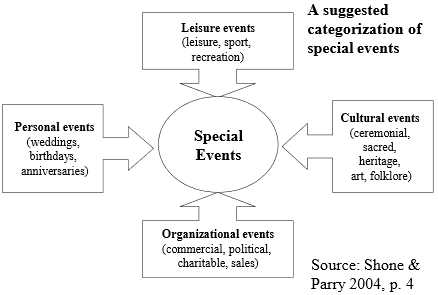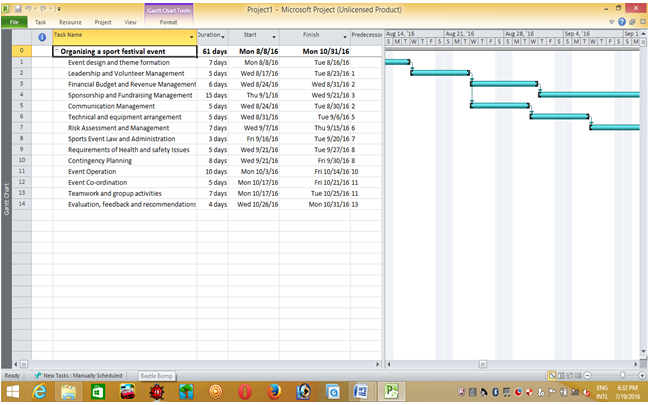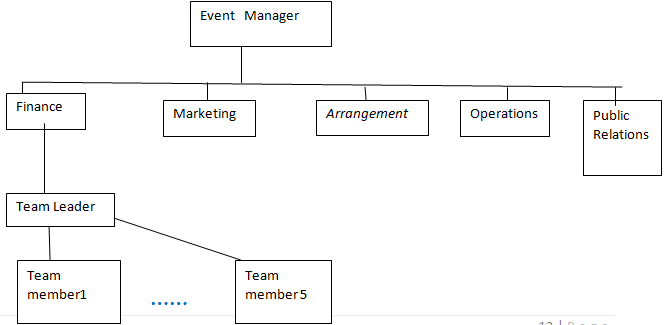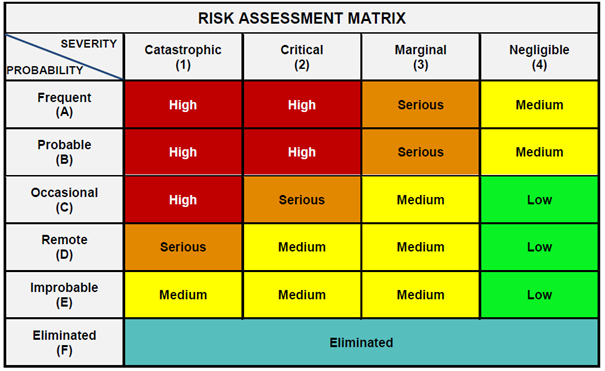Describe about the Case Study for Sports Festival Event.
Executive Summary:
Events are naturally held in a particular season that has finite length and should be planned, fixed and publicized. The various festivals may be arranged as events. Among them, sports festival event is the most common and necessary event for University, college and school level. This event must be co-related with the venue(s), time, duration, budget, participants, staffs, scope, policy, target audiences, team management, planning, risk assessment and evaluation.
The sports festival event can be treated as special event that is very useful for breaking the monotonous life of the target audiences and gives an opportunity for a social, leisure and cultural experiences to them (Getz, 1997, p.4).

To plan the sports festival event, the parameters should be considered as, number of participants, their participating team or institution’s background, fixing the age and gender for the participants, their participating criteria, methods of inviting participants (like phone call, e-mail, inter-college association etc.), facilities offered to the participants, collecting sponsorships for the event, arranging equipments, starting time, duration for the event, number of sub-events and their features, refreshments for the event, arranging prizes and certificates, inviting guests and audiences, involving press and arranging photos or video for the event.
Besides the above pre-event planning, the organizers should consider the post-event activities like collecting and collation of feedback, evaluation of events, control aspects and recommendations for future events. The overall organization and planning of sports festival event has lots of learning outcomes for the students/ organizers like implementing leadership capabilities in a practical situation, working in a team based environment and taking necessary instant decision, implementing the financial and budgetary issues to the event management, identifying risks, health and safety issues as well as rules and regulations pertaining to the event industry, the different control and evaluation policies for the event. These are very much helpful for their future job industry.
Objectives and scopes for the project:
Organizing sports festival event is very much needed in today’s competitive environment for increasing team building capacity as well physical spirit. An organizing event especially sports event can bring to an individual satisfaction in respect of financial planning, organization’s reputation as well as global identification. For organizing and developing fair sports event management by organizing institution, ethical policy adoption is very much needed for the stakeholders. An effective event management system tends to develop evidence-based knowledge and collective action by organizers. There are mainly two themes for organizing sports event management system, like institutional positioning and building inter-institutional relationship.
According to different research, the SMART (Specific, Measurable, Achievable, Relevant and Time-based) principle is essential for event planning. In case of a particular situation, the SMART principle must ensure the activities like economic benefit, event sustainability, social benefit, event quality, event growth, community development, audience or participant satisfaction, sector development and educational development.
The SMART objectives of the event are:
To quantify challenges and benefits of permissive legislation regarding COA (Cost of attendance) by determining potential challenges and strength of COA policy in order to determine what potential changes are required in current athlete structure. The event will promote university’s identity as a place to learn, Visit, live and work at excellence.
To encourage student athletes by fueling them with necessary scholarship. The work will work throughout the academic year.
To create a broad platform for student athlete by addressing strategic goals for student athlete welfare and fostering a championship culture.
To promote fitness to local community by organizing public sport functions to encourage people to participate in the event even if they are not students.
(Arksey & O’Malley 2005) (Backman, Uysal and Sunshine 1995).
Research and background Information :
From the various previous studies & researches and guidelines for organizing and planning events especially sports festival planning events, the information is collected that should help to organize and implement the event smoothly. According to the Event Scotland guide, any event must cover the sections including the event concept and its description, identifying the event’s vision and mission, setting the event’s objectives, the SWOT analysis for the event, deciding event’s venues and dates and the action plan for the event. The successful event must be based on the strong concept, objective and scope. Determination whether the event is developed a particular cultural or sporting activity, celebrating the festival as a unique aspect with local community, encouraging more visitors and audiences to participate with the event by spending time and money, encouraging the local community’s activities with this event and marking an opening ceremony for the event.
The identification and communication between vision and mission statement for the event is an important aspect. For example, the vision statement for the event may be,
To achieve one of the top positions of the world’s foremost sports events destinations by 2020.
The Mission statement should be,-
To deliver a high-quality sport festival by attracting more visitors and sponsors, to enhance institutional profile, to maximize the economic, cultural and social benefits of events throughout the country
The SWOT (Strength, Weakness, Opportunity and Threat) analysis is very much needed before organizing an event. The features like event management (experienced team within organization, financial viability, good planning, and growing audience base) are the major strengths for the organization. Lack of marketing and promotional activities, remote location, limited sponsorship support, transport problem etc. are major weakness for organizing any event.
(A reference for event planning and production in Scotland 2006)
According to the journal report of “Physical Education and Sport Management”, achievement of festival for sports depended upon the output and evaluated the activities of the stakeholders’ operations. The festivals were intended to upgrade the different sports facilities in the states. (Edori ,1985; Okojie, 1985; Amuchie, 1990)
Event Venue: National playgrounds, tennis center, soccer stadium and other government sport areas.
Sports activities: Gold tournament, pool shoots out, tennis tournament, golf tournament, football, and volleyball and soccer tournament
Catering: Pre-game and post game diet for participants, complimentary drinks for visitors and food for guests.
Budgeting of the Project:
After planning the event, budget determination is necessary. In this case, the budget is prepared according to the income and expenses for the event. First, a draft budget is prepared by assumption the rates of the different items for the proposed sports event. When, the proposed event is progressing, a second budget is formed by taking the real rates of the items for the event. It is more practical budget and the rates for the first budget are updated. After completion the event, the final budget is prepared that will be real and operational of the second budget.
Feasibility study Analysis:
The itemized budget is made by taking the technical requirements, vendors and other services for the development of the event. The different sources of funds should be identified and arranged for the festival. The different sources may include, sponsorship (public or private), volunteer contribution, participation fees, fundraising, bank interest for event, public contribution, contribution by local council etc. The required funds should be utilized in a way so that the profit margin should be increased. The sports festival event is a social gathering that attracts more participants and sponsors which offers an economic benefit.
The different expenses and incomes for the sports festival event can be shown as below,-
Expenses:
|
Item |
Cost (‘000 in £) |
|
Transport cost: |
890 |
|
Travelling expenses |
220 |
|
Allowances |
300 |
|
Medical exp |
150 |
|
Guests and Judges |
220 |
|
Marketing: |
1200 |
|
Posters |
50 |
|
Journal |
170 |
|
Communication media |
200 |
|
Certificates |
80 |
|
Promotional gifts |
640 |
|
Press contact |
60 |
|
Technical Equipment |
558 |
|
PC, laptops, projectors |
70 |
|
Loudspeakers |
40 |
|
Display screens |
25 |
|
Video |
25 |
|
Sport material |
18 |
|
Voice and interpreters |
300 |
|
Other stationery exp |
80 |
|
Venue |
1500 |
|
Hiring the sport facilities |
1500 |
|
Catering |
400 |
|
Launching the festival |
400 |
|
Insurances |
300 |
|
Other Misc. Expenses |
250 |
|
Grand Total: |
5098 |
Incomes:
|
Item |
Amount (‘000 in £) |
|
Collection from Participants |
1300 |
|
Sponsorships (public & private) |
3200 |
|
Volunteer contribution |
800 |
|
Public Institutions |
1200 |
|
Grand Total |
6500 |
Profit= Income-Expenses= 6500,000-5098,000= € 1402,000
The above example is a sample budget for organizing a sport festival event.
(Brookes & Landry 2002).
Summary of the Target audience and market:
There are mainly two types of target market in case of sports festival- one is the participants and the other is the audiences, fans and spectators. So, both participants and audiences are necessary for any event program. The marketing policy is to reach the both types of target audiences and increase the audience base. Based on the different sports events, the total market should be segmented as psychographics, geographic and demographic factors. The main aim of the segmentation of market is to identify customer’s needs. Event managers should decide the sports events by surveying the segmented markets. For example, the event manager can arrange an event about sports quiz, chess and carom competition for 10-18 years children. This will be very attractive and target the local school children. The school children can attend the competition as participants or audiences- this will meet their geographic (local) and psychographic (self-interest) behavior.
Local communities: The event is not targeting students only but other people as well to promote local fitness.
Families: The event doesn’t sports individual games rather it provides families to participate in the event.
Age: All people above age 4 as the event includes games for family and it aims to promote fitness in local community. So visitors can get motivated to plays sports even if they are not participating. In addition to that scholarship, prizes and opportunities to athlete will encourage people of ages.
According to Boone and Kurtz (2002), the market segmentation must meet the following criteria,-
The segmentation should provide purchasing power and size that is measurable.
The segmentation should provide an appropriate profit-level.
The organization’s market segmentation must offer the product at an appropriate price.
The organization’s marketing policy must prompt the particular segment.
To select the target market, a mass-market approach would be adopted where the appeal would be successful with less marketing effort. A sport event has an appeal to all people of various age groups, various regions, different interest levels, individual or a family unit as well as reaches to different income groups. So, selecting a mass market, the sport event would be very successful. Again, many sport events would need market that are differentiated by the segmentation process. For example, arranging a sports event in an off-speak hours would require a differentiation process via a niche approach. This would need more focused in local schools or women’s groups (Kotler & Armstrong 2004).
Tools and techniques used for the project:
The necessary modules for “Organization and development of sports festival event ” are shown as below,-
Event design & theme formation
Leadership & volunteer Management
Financial Budget, Revenue Management
Sponsorship and Fundraising Management
Communication Management
Technical and equipment arrangement
Risk Assessment and Management
Sports Event law and administration
Requirements of Health and Safety issues
Contingency Planning
Event operation
Event co-ordination
Teamwork and group activities
Evaluation, feedback and recommendations
The duration for each and every above task as well as their starting and ending time can be drawn in project management tool like Gantt chart. Assume sports festival process will start on 8/8/2016. In the Ms-Project 2010 software, the tasks and their duration with task dependencies are shown,-

Fig 1: Project scheduling

Fig 3: Gantt chart
(Source: Author)
The outcomes for the project may be as follows,-
The impacts of funding, financial resources and budgeting applied to event management.
The knowledge of marketing and infrastructural requirements is applied to the sports event.
By identifying the appropriate laws and regulations in the event industry, the risks, health and safety issues are considered in the sports event.
The event management operation is implemented with the help of team based environment by using the event management principles.
The team performance is evaluated during the execution of the event.
By collecting and evaluating customer’s feedback, the event is measured whether it is success or failure.
(Lee & Goldblatt 2012).
Team Management process and structure:
The project team is organized by volunteers of 20 organizers or students and additional averaged 5 people per sports event. The motto for successful event operation is the communication, cooperation and collaboration among team members. The following guidelines should be accepted for the team management,-
Provide a written statement of duties for each individual in a team per event. There should be a team leader for an event.
The team leaders are responsible to take adequate management training from experts or seniors.
The chain of command and reporting procedures must be implemented in each team.
The team leaders must have sufficient knowledge and training about leadership, communication, team building, organizing, business planning, financing, conflict resolution between the team members, confidence building in the team, event laws and safety rules etc.
The festival manager should provide adequate care and co-ordination between the staffs for the team members.
The main committee is constructed by 20 organizers. The sub-committees can be formed in case of arranging larger sports festival. The extra 5 organizers can be appointed for each sub-committee. The sub-committee should include Finance, Marketing, Arrangement, Operation and Public relations etc.
The structure may be as follows,-

Fig: Structure for Team Management
(source: Author)
In the same way, Marketing, Operations, Arrangement and Public Relations have one Team leader each and under one team leader there should be 5 team members.
Stakeholder assessment and communication for the project:
Various personnel who are associated and interested for the proposed project, sports festival management are the stakeholders. The stakeholders are identified and their assessments are done.
Local and Federal Government ( Written communication via letter)
Board of directors for the organization. ( Written communication via mail)
Sponsorship companies (public and private). ( Written communication vial mail)
Organization’s approval committee. ( Written communication vial mail and letter)
Organization’s finance officers, event managers. ( Written communication vial mail and verbal communication via telephone)
Local community organizations (Fax, email, phone).
Participants (Media).
Audiences, guests & visitors (Media).
Judges (Written communication vial mail).
Employees of the Organization (Fax, email, phone).
Vendors for supplying other resources (Fax, email, phone).
Team leaders and team members (Fax, email, phone).
Local institutions (Fax, email, phone).
NGOs.
Local sport clubs.
Competitor institutions.
Volunteers and donors.
The above stakeholders’ interest and their influence for the project can be shown in the following matrix.
High (Influential level)
|
Involvement:
|
Empower:
|
|
Information:
|
Consult:
|
Table 1: Analysis Matrix(stakeholder).
(Buch, Milne & Dickson 2011).
Planning for risk management:
Risk assessment of event activities is an important part to avoid failures in a project. It allows identifying, mitigating, categorizing and prioritizing the risks of an event. Risk assessment is an essential step in risk management planning because it provides quantitative and qualitative value of a risk so that high risks can be mitigating earlier and can be best avoided. Risk matrix is one of the most used tools for assessing the risks of the project (Gladden, 2012). Mentioned below is the risk matrix of the event.
|
Severity probability |
Catastrophic |
Critical |
Marginal |
Negligible |
|
Frequent (injury and medical emergencies ) |
High |
|
|
|
|
Probable ( delay in events or lack of leadership) |
|
High |
|
|
|
Occasional (9clutural differences ) |
|
|
Medium |
|
|
Remote competitive attitudes) |
|
|
Medium |
|
|
Improbable (political issues) |
|
|
|
Low |
The reference matrix of above value has been given below.

At the time of progressing the project, several risks can be added that can hamper the system. The following may be acceptance criteria for mitigating the risks.
A core committee can be constructed for monitoring, maintaining and controlling the safety activities of event. The core committee can check all issues related to event quality, finance, ethical, security and legal as well as take necessary action if applicable.
The efficient team members should be appointed by proper management training.
The expert advice for legal, financial, administrative and security may be formulated by the Event Manager.
Event managers should hire the equipments and highly-sophisticated necessary tools and technology from reliable vendors.
The event organizing committee and sub-committees must be free from political issues and maintain ethical, security and healthy environment.
Besides the above risks, the various risks like fire, noise pollution, accidental damage of any equipment, electrical malfunctioning, and difficulties like heavy audience may be occurred during the event festival.
The various mitigation policies for the risks can be taken as venue evaluation, noise control, fire precautions, medical service provision, electrical services, audience management, sanitary accommodation and food safety management.
( Polkinghorne, Massey, Durrheim, & MacIntyre 2012).
Control and Evaluation of the project:
The design, development and operation of sports festival event may be guided with quality assurance policy. The quality assurance for the sports festival event may be discussed as follows,-
Primary Assessments: It can be done at the planning phase of the project by event selection, venue selection, date & time selection. The different objectives, scopes, needs, vision, mission, policy and strategy should be identified and measured in this phase. The risk assessment related to physical, financial and operational should be done.
Evaluation & improvement: After planning, the quality plan related to monitor the activities for the different sub-committees like Marketing, Finance, Public Relations, Arrangement, and Operations must be formulated. In this respect, marketing plan, strategies and techniques should be implemented to reach the target audiences.
First, the event evaluation criteria should be defined. The evaluation process can be done by collecting feedbacks from participants, audiences, visitors, guests, judges. The feedback from event management team leaders as well as members can be taken.
The evaluation and monitoring for the sports festival event can be done as follows,-
Formative- This type of evaluation is measured throughout the project.
Active- This is a type of monitoring process during the event.
Summative- This evaluation is conducted at the end of the event.
After active and formative evaluation procedure, the suitable control policies can be taken and applied to the rest of the event. But, after summative evaluation procedure, the control policies and recommendations can be applied to future event.
(Arts Derbyshire 2011)
The formative and summative monitoring will be used in the project. The feedback forms for formative monitoring have been given below. The formative assessment will be done by taking feedback of team mates and staff members on method and usability of events.
|
Issue |
Formative evaluation |
|
Purpose |
Ongoing assessment of quality and effectiveness of the program |
|
Overall evaluation Question |
Has the event been managed and implemented as it was planned? |
|
Specific evaluation questions |
What is been working? What should be improved? How things needs improvement can be changed? Which interventions are being used? Has the interventions implemented with fidelity? |
The summative evaluation will be done with help of all participants of events such as athlete, sponsors and visitors as well. The example of survey questionnaire has been given below.
|
Issue |
Formative evaluation |
|
Purpose |
To determine degree of effectiveness event has accomplished its goals |
|
Overall evaluation Question |
Are the efforts been done have positive impact of student or how successful it been in achieving its mission? |
|
Specific evaluation questions |
What was most effective and successful event? Who has been affected? Were things on time or as promised? How did it help to promote local community fitness? Was it a successful event? |
The event aims to create a sport event that can promote student athlete, can improve university’s identity in positive manner and can promote local community fitness. The event is not planned for student’s athlete but for other people as well to promote local fitness. The target market of the event consist of all above age 4 as it aims to reduce culture differences and to encourage fitness. The planning of the event has been done to achieve academic advantage, economic benefit, advantages of geo political issues etc.
The scope of the event admires several advantages discussed in the paragraph. The spreading of education and research would be increase through inter-relationship between the Universities and Institutions. The relationship can be grown by different events. Sports festival event is one of the most popular events organizing by one institution. The students can show and share their knowledge, leadership qualities as well expertise to other institutions. The different sponsorship companies can contribute funds for the event. The organizers should communicate and invite the sponsors. These are very helpful for the organizing institution. The communication between communities by increasing moral values, economic policy, human benefits, ethical policy, and public rights can lead to build a dynamic environment.
Books:
Diana Azmi, Getz (1997) Event Management Chapter 1. UK: RoutledgeKotler, P & Armstrong, G (2004). Principles of Marketing (10th Ed.). New Jersey: Pearson Education Inc.
Journal:
Arksey, H. and L. O’Malley (2005). “Scoping studies: Towards a methodological framework”, International Journal of Social Research Methodology 8.1, pp. 19-32.
Backman, K.F., S.J. Backman, M. Uysal and K.M. Sunshine (1995). "Event tourism: An examination of motivations and activities", Festival Management and Event Tourism, Vol. 3, pp.15-24.
Edori CS (1985). Reports of the 6th national sports festival, Kwara’ 85. Port Harcourt: Rivers State Sports Council. pp.4-5.
Amuchie FA (1990). Psychosocial approach to training of soccer player. The preparation of Nigerian soccer player for international competition. In: L.O. Amusa and A.P. Agbonjimi (Eds). Application of Sports Science and Medicine to Soccer. NASSM J. pp.9-14
Okojie C (1985,). Ilorin for a Jamboree called sports festival. Nigerian Vanguard Newspaper. December.
Brookes, F. and C. Landry (2002). Good Times. The Economic Impact of Cheltenham's Festivals. Stroud: Comedia
Lee, S. and J. Goldblatt (2012). “The current and future impacts of the 2007-2009 economic recession on the festival and event industry”, International Journal of Event and Festival Management, 3.2.
Buch, T., S. Milne and G. Dickson (2011). “Multiple Stakeholder Perspectives on Cultural Events: Auckland's Pasifika Festival”, Journal of Hospitality Marketing & Management, 20.3-4, pp., 311-328
Polkinghorne, B., P. Massey, D. Durrheim, T. Byrnes and C. MacIntyre (2012). Prevention and Surveillance of Public Health Risks During Extended Mass Gatherings in Rural Areas: The Experience of the Tamworth Country Music Festival. Australia: Public Health
Gladden, R. (2012). The Project Risk Maturity Model: Measuring and Improving Risk Management Capability. Proj Mgmt Jrnl, 43(5), pp.101-101.
Websites:
A reference for event planning and production in Scotland [online] available from https://www.eventscotland.org [ September 2006]
Arts Derbyshire [online]. Festivals Toolkit: Strategic Planning: Monitoring and Evaluation. Available from https://www.artsderbyshire.org.uk/projects/festivals_toolkit/strategic_planning/monitoring_evaluation/default .asp [2011]
To export a reference to this article please select a referencing stye below:
My Assignment Help. (2017). Case Study: Sports Festival Event. Retrieved from https://myassignmenthelp.com/free-samples/sports-festival-event-case-study.
"Case Study: Sports Festival Event." My Assignment Help, 2017, https://myassignmenthelp.com/free-samples/sports-festival-event-case-study.
My Assignment Help (2017) Case Study: Sports Festival Event [Online]. Available from: https://myassignmenthelp.com/free-samples/sports-festival-event-case-study
[Accessed 01 June 2025].
My Assignment Help. 'Case Study: Sports Festival Event' (My Assignment Help, 2017) <https://myassignmenthelp.com/free-samples/sports-festival-event-case-study> accessed 01 June 2025.
My Assignment Help. Case Study: Sports Festival Event [Internet]. My Assignment Help. 2017 [cited 01 June 2025]. Available from: https://myassignmenthelp.com/free-samples/sports-festival-event-case-study.
